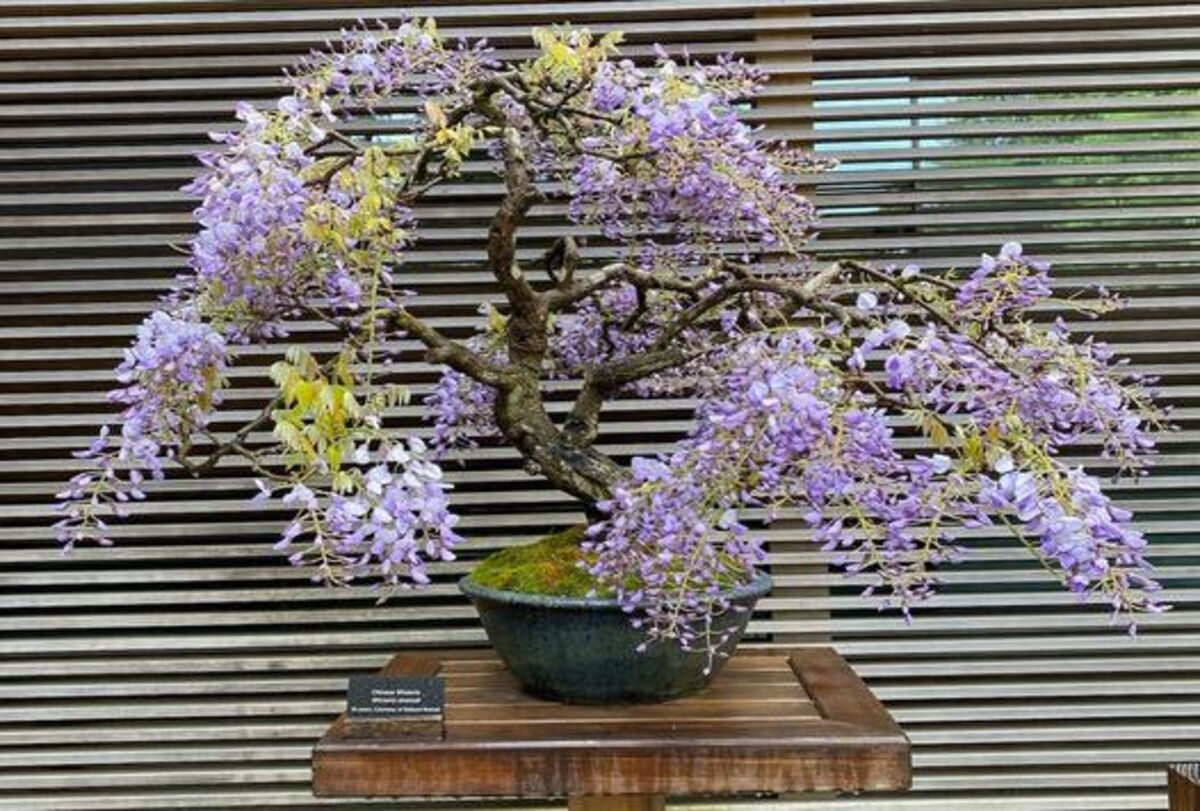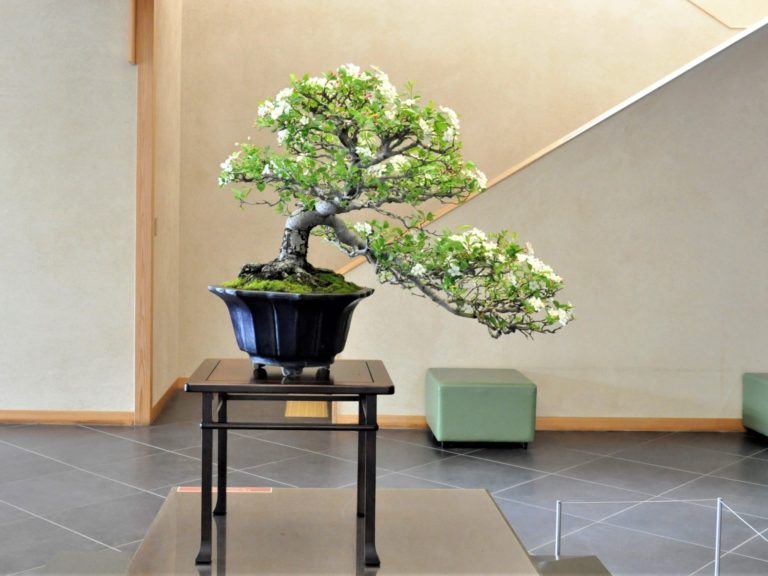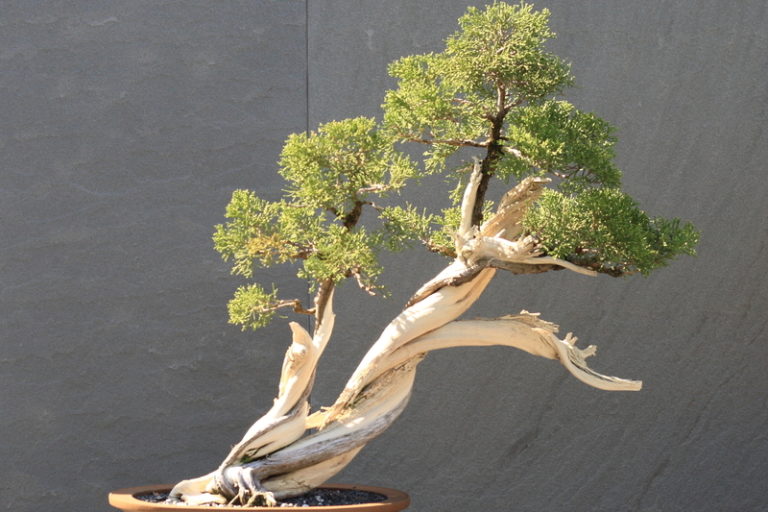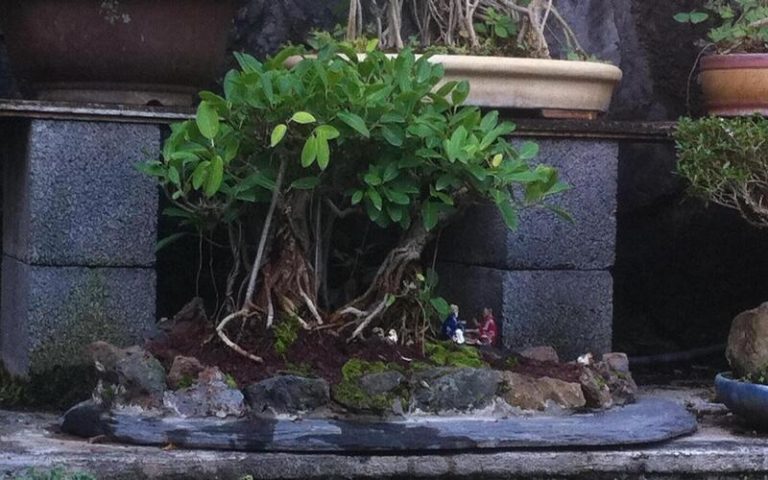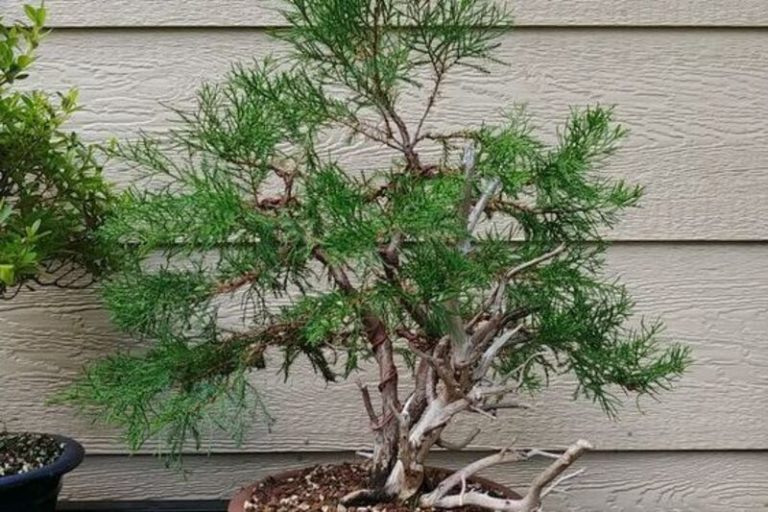Wisteria Bonsai: A Stunning Miniature Masterpiece
Hello and welcome to the beautiful world of Wisteria Bonsai! You’ve come to the right place if you’ve ever been amazed by the beauty of bonsai trees and wanted to know how to make your own small work of art. We’ll show you the easy steps you need to take to grow and take care of a Wisteria bonsai, making your gardening dreams come true.
What is Wisteria Bonsai?
Wisteria bonsai is a small tree made from Wisteria branches by carefully cutting and shaping them in the bonsai style. These small trees look like the beautiful long bunches of flowers that Wisteria has, but they are more compact. Wisteria bonsai needs a lot of care and skill to grow, but the flowers that fall from the branches are very pretty.
History and Origins of the Wisteria Bonsai
Wisteria bonsai has a long past that goes back to ancient Asian countries, especially those in China, Japan, and Korea. Growing Wisteria as bonsai probably started hundreds of years ago, but there aren’t many written records of this.
1. Ancient China: The art form of bonsai began in China more than a thousand years ago. Japanese gardeners were the first people to grow small trees in pots, which led to the development of the art of bonsai. With its pretty flowers and graceful branches, wisteria would have fit right in with these tiny settings.
2. Japan: During the Kamakura time (1185–1333), growing bonsai, including Wisteria bonsai, became very famous in Japan. Japanese teachers and scholars did a lot to improve the ways that bonsai trees were grown. Wisteria, which was thought to represent beauty and life, became popular among bonsai artists. Over many years, the Japanese improved the art even more, making it a highly regarded way to show oneself artistically.
3. Korea: Korean bonsai art has roots in the same places as Chinese and Japanese bonsai art, but it has its own style. Wisteria bonsai probably made its way to Korean bonsai culture because it is famous there and looks nice. Wisteria bonsai has grown as an art form with the help of Korean artists, just like those from China and Japan.
Many people still love and admire Wisteria Bonsai as a way to grow bonsai today. People all over the world enjoy the delicate beauty of Wisteria Bonsai, which pays tribute to its Asian roots. As bonsai became popular around the world, the Wisteria Bonsai became a sign of patience, skill, and the deep link between people and nature. It also showed how appealing this old and interesting art form still is.
Wisteria Bonsai and Their Symbolism
Wisteria bonsai, with its flowing branches and floating flowers, has deep meanings in many cultures. It often stands for things like love, life, and the passing of time. Here is a more in-depth look at what the Wisteria Bonsai means:
1. Longevity and Immortality: Wisteria is often linked to long life and death in many Asian countries, such as China and Japan. Because it looks beautiful for a long time and can live for many years, it is a sign of a long and happy life.
2. Beauty and Grace: The beautiful flowers that hang from wisteria are a sign of beauty, grace, and charm. When it comes to bonsai, Wisteria Bonsai is a great example of the skill and talent needed to shape and care for a live work of art.
3. Patience and Endurance: To get the shape and number of flowers you want from a Wisteria bonsai, you have to be very patient as the plant needs years of careful cutting and training. The wisteria bonsai plant is a lesson of the benefits of being patient and dedicated over time.
4. Romance and Love: When it comes to flower language, wisteria often stands for romantic love, sensitivity, and showing how much you care. Wisteria bonsai is a popular choice for nature and beauty lovers because the flower groups fall over each other in a romantic way.
5. Transformation and Adaptability: In Wisteria Bonsai and other forms of bonsai art, the changing power of nature and human action is shown. To be able to adapt, change, and find beauty in even the worst situations is what it means.
6. Symbol of Spring: Wisteria usually blooms in the spring, which is a sign of new life, growth, and the start of a new season. The bright flowers on this plant bring joy and hope as they mark the end of winter.
7. Spiritual Significance: Wisteria is linked to faith and wisdom in some cultures. People think that its winding plants and lots of flowers are like the complicated ways that lead to spiritual awakening.
Wisteria Bonsai is a sign in the world of bonsai that goes beyond just how beautiful it is. It also represents the patience and determination needed to care for it. Wisteria Bonsai is a popular choice for bonsai growers because it combines natural beauty, artistic expression, and deep meaning in a way that works well for both bonsai lovers and fans.

Characteristics of the Wisteria Bonsai
Wisteria Bonsai is a popular choice among bonsai fans because of its beautiful vines and lots of flowers that fall over like waterfalls. Some important things about the Wisteria Bonsai are listed below:
Cascading Blooms: One of the most beautiful things about Wisteria Bonsai is the way its long, trailing flower groups hang from its branches. The different shades of blue, violet, pink, or white in these flowers make a beautiful flowing effect.
Twisting and Twining Vines: The beautiful way that wisteria plants naturally twist and twine is shown off in Wisteria Bonsai. It is an interesting bonsai because the stems are bending, which makes it look more interesting.
Compound Leaves: Flowering wisteria Each bonsai leaf is made up of several smaller leaflets that are grouped along a center stem. The leaves are usually bright green and form a thick covering that makes the bonsai look better.
Fragrant Flowers: Depending on the type, Wisteria Bonsai often has flowers that smell good, which makes it even more beautiful. The sweet smell of the flowers makes looking at and taking care of the bonsai more enjoyable.
Deciduous Nature: Like wisteria trees that are much bigger, wisteria bonsai loses its leaves in the fall. This natural cycle lets bonsai lovers enjoy the tree’s beautiful spreading structure in the winter, which adds to its beauty.
Trunk Characteristics: When Wisteria Bonsai is old enough and trained properly, its body gets interesting and textured. The trunk can get twisted and rough over time, which shows how old the bonsai is and how much time has passed.
Patience and Longevity: Because it grows slowly, Wisteria Bonsai needs a lot of patience to grow. But with the right care, a Wisteria bonsai tree can live for many years, giving its fans a chance to enjoy its beauty and meaning for a long time.
Seasonal Changes: Wisteria Bonsai changes with the seasons, especially the way it blooms. In the spring, the tree blooms with bright colors, making a sight to behold. To properly care for a Wisteria bonsai, you need to understand and enjoy these yearly changes.
Training Potential:
Pruning and teaching methods work well on wisteria bonsai. Artists who make bonsai trees can change the tree’s structure, branches, and top, which lets them show their creativity in many ways. Because the branches are flexible, it can be used for a number of bonsai styles, such as simple upright and flowing.
Overall, Wisteria Bonsai is a beautiful and satisfying choice for bonsai fans because of its cascading blooms, twisting vines, fragrant flowers, and patient care needs. It shows off nature’s beauty in tiny form.
How to Grow Wisteria Bonsai
It can be gratifying and take a lot of time to grow a wisteria bonsai. To grow and take care of a Wisteria Bonsai, follow these steps:
Selecting the Right Wisteria Variety: Select a Wisteria variety that is appropriate for bonsai cultivation. Wisteria sinensis (Chinese Wisteria) and Wisteria floribunda (Japanese Wisteria) are common varieties. Consider your climate and available space when selecting a plant species.
Choosing the Right Container and Soil: Choose a bonsai pot that drains well so that water can pass. Use a bonsai soil mix that is well-balanced and drains quickly. Every two years or when you see that the tree is getting too big for its pot, you should repot it.
Planting and Pruning: In the pot, plant the Wisteria twig. Make sure the roots are spread out and covered with soil. Cut back the roots a bit when you repot the plant. Pruning is an important part of creating your Wisteria bonsai. Cut back the stems, leaves, and shoots on a regular basis to keep the shape and structure you want.
Training Techniques: As you wire the twigs, gently shape them. Wisteria can be wired because its branches are flexible. Check the lines often so that they don’t cut into the tree’s wood as it grows.
Watering: Wisteria bonsai needs to be watered regularly. When the earth feels a little dry, give the tree a lot of water. Wisteria doesn’t like dirt that is too wet, so don’t water it too much. You may need to water more often when it’s hot outside.
Fertilization: A balanced organic fertilizer should be used to feed your Wisteria bonsai in the spring and summer when it is growing. To help healthy growth, fertilize every two to four weeks. When the tree is dormant in the fall and winter, cut back on or stop fertilizing it.
Sunlight and Temperature: The wisteria bonsai does best in full sun. You should put your bonsai somewhere that it will get at least six hours of straight sunshine every day. Winter is a good time to protect it from strong winds. Even though wisteria bonsai is hardy, it’s best to protect it if the weather gets really cold.
Pruning for Flowers: Carefully trim the Wisteria bonsai to get it to flower. Take off any extra leaves and shoots to let air and sunshine reach the inner branches. New growth has flower buds on it, so prune in a way that encourages both growth and blooming.
Pest and Disease Management: Watch out for bugs like aphids and worms. Use insecticidal soap right away to get rid of pests. To avoid fungus diseases, make sure there is good air flow. Check the leaves and stems often for signs of problems.
Winter Care:
To keep your Wisteria Bonsai safe from frost, move it to a warm, dry place or cover it with frost cloth. During the winter, water less, but don’t let the soil dry out totally.
Remember that it takes time and patience to grow a Wisteria bonsai. You will have a beautiful and healthy tiny tree over the years if you take care of it, prune it, and pay attention to its special needs.
Displaying and Showcasing the Wisteria Bonsai
Displaying and showcasing a bonsai Wisteria is a lovely way to emphasize the natural elegance and allure of this particular tree. Wisteria bonsai, renowned for their cascading clusters of fragrant, violet blossoms, are prized for their aesthetic value. Here are some suggestions for displaying and highlighting your Wisteria bonsai:

Select an Appropriate Pot: Chose a bonsai pot that fits the style and size of the tree. Wisteria bonsai can do well in a pot that is either square or oval. To allow for good growth, the pot should be a little bigger than the root ball.
Positioning: Most wisteria bonsai grow in styles called “cascade” or “semi-cascade,” where the flowers and branches fall gently over the sides of the pot. Placing the tree in a way that shows off its falling branches is important.
Bonsai Stand: Place the bonsai on an elevated stand or platform to elevate it to eye level, allowing for better viewing and appreciation.
Lighting: Make sure that your Wisteria shrub gets enough sunlight. For these plants to grow well and make lots of flowers, they need a lot of light. Bring the shrub close to a sunny window or, when it’s time to grow, move it outside where it can get lots of light.
Display During Bloom: When your Wisteria bonsai is blooming is the most beautiful time to show it off. Make sure it’s in great shape and put it somewhere noticeable when the beautiful flower waterfalls are in full bloom.
Accent Elements: To make your bonsai show look better, you could add small figurines, rocks, or accent plants to the pot.
Remember that patience and regular care are the keys to taking good care of a bonsai. If you take good care of your Wisteria bonsai, it will become a beautiful focal point in your home or yard, showing off its artistic shape and natural beauty.
How to Care for and Maintain a Wisteria Bonsai
A Wisteria bonsai can be rewarding to care for and keep, but it can also be hard to do because of the way Wisteria grows. To help you keep your Wisteria bonsai healthy and growing, here are some important care and management tips:
Light and Temperature:
- For flowers and to grow, wisteria bonsai needs a lot of direct sunlight. Put your bonsai somewhere that it will get at least 6 to 8 hours of sunslight every day.
- The wisteria bonsai likes a mild temperature. Keep it safe from very cold or very hot weather, especially in the winter.
Watering:
- Maintain consistent soil moisture, but avoid waterlogging, which can cause root decay. When the top 1-2 inches of soil become barely dry, water the plant.
- During the growing season, which typically lasts from early spring to early autumn, you may need to irrigate your plants more frequently. When the tree is inert in the winter, watering should be reduced.
Fertilization:
- During the growing season, apply a balanced, slow-release bonsai fertilizer or liquid fertilizer. Follow the instructions on the product’s label.
- This can result in excessive vegetative growth at the expense of fruiting.
Pruning and Training:
- Prune your Wisteria bonsai regularly to maintain its shape and promote flowering. Wisteria can be vigorous growers, and without pruning, they can become unruly.
- Use sharp bonsai shears to trim back branches and foliage as needed. To encourage a more compact growth habit, pinch back on new growth regularly.
- Wiring can be used to shape the branches. However, be cautious, as Wisteria has brittle branches that can easily snap.
Repotting:
- Every two to three years, typically in early spring before the growing season, repot your Wisteria bonsai. Select a slightly larger container to accommodate the plant’s expanding root system.
- During repotting, prune the roots gently, removing no more than one-third of the root mass.
Soil:
- Use well-draining bonsai soil to ensure good root health. A mix of akadama, pumice, and lava rock is a common choice for bonsai soil.
Disease and Pest Control:
- Observe for common bonsai parasites such as aphids, scale, and spider mites. Treat infestations immediately with the appropriate insecticides or by removing the pests manually.
- Ensure the bonsai has adequate air circulation to prevent fungal diseases. Remove any diseased or decaying branches.
Flowering Care:
- Typically, Wisteria bonsai bloom in the spring. Remove spent blossoms after the flowering season to promote future flowering.
- After flowering, you can also perform extensive pruning to shape the tree and remove undesirable growth.
Winter Care:
- In regions with severe winters, move your Wisteria bonsai to a protected location, such as an unheated garage, during frigid temperatures.
- The plant will be inert during the winter and will not require as much water.
Patience:
- Growing a Wisteria bonsai from seed or immature plants may take several years, so be patient and consistent with your care and training efforts.
It can be a labor of love to maintain a Wisteria bonsai, but its magnificent display of cascading flowers and artistic form make it a prized addition to any bonsai collection. Your Wisteria bonsai will thrive with regular maintenance and attention to its particular requirements.
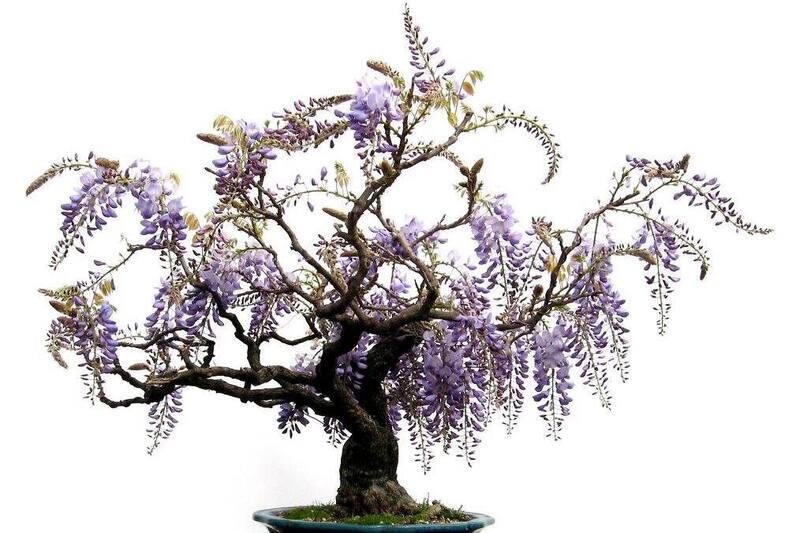
Wisteria Bonsai Care Sheet
| Aspect | Care Tips |
|---|---|
| Watering | Keep the soil consistently moist, but avoid waterlogged conditions. Water when the top 1-2 inches of soil become slightly dry. Adjust frequency based on environmental conditions and season. |
| Sunlight | Provide 6-8 hours of direct sunlight per day. Ensure your Wisteria bonsai receives adequate light to promote flowering. |
| Temperature | Protect the bonsai from extreme heat or cold. Provide a temperate climate for optimal growth. |
| Humidity | Maintain moderate humidity levels. A humidity tray or regular misting can help in dry indoor environments. |
| Fertilization | Use balanced, slow-release bonsai fertilizer during the growing season. Follow product instructions for application. Avoid over-fertilization. |
| Pruning and Trimming | Regularly prune to maintain shape and encourage flowering. Pinch back new growth and remove dead or unwanted branches. |
| Wiring and Styling | Use wiring to shape branches but be cautious, as Wisteria has brittle branches. Carefully apply wire to achieve the desired cascading style. |
| Repotting | Repot every 2-3 years in early spring using well-draining bonsai soil. Prune roots conservatively, not exceeding one-third of the root mass. |
| Pest and Disease Control | Keep an eye out for common bonsai pests (aphids, scale, spider mites). Treat infestations promptly. Ensure good air circulation to prevent fungal diseases. |
| Winter Care | In harsh winter regions, provide shelter in an unheated garage. Reduce watering, as the plant is dormant. Protect the bonsai from freezing temperatures. |
| Regular Maintenance | Maintain patience and consistent care. Remove spent blooms after flowering and consider a more extensive pruning to shape the tree and remove unwanted growth. |
By following to this care guide, you can maintain the health and vitality of your Wisteria Bonsai, showcasing its gorgeous cascading flowers and artistic form.
Conclusion
Growing a Wisteria Bonsai is a fun and interesting project. If you give this beautiful tiny tree the right conditions, give it regular care, and be patient, you can enjoy its graceful beauty and lovely cascading flowers. If you take good care of your Wisteria Bonsai, it will grow and become a beautiful focal point in your home or yard, bringing the beauty of nature closer to you.
FAQ
Q1: What is a Wisteria Bonsai?
A: Wisteria Bonsai is a miniature version of the Wisteria vine, which is trained to grow in a bonsai pot. It displays the same cascading clusters of fragrant flowers as the full-sized Wisteria.
Q: Can I grow a Wisteria Bonsai indoors?
A: A Wisteria Bonsai can be grown indoors, but it needs to be in direct sunshine. Most of the time, it’s better to leave them outside and only bring them inside for short amounts of time to enjoy the flowers.
Q: How do I get my Wisteria Bonsai to flower?
A: Most wisteria bonsai bloom in the spring. Make sure your bonsai gets enough sunshine and is pruned and fertilized correctly to get it to bloom.
Q: When should I prune my Wisteria Bonsai?
A: To keep the bonsai’s shape, it needs to be pruned often. After the flowers have bloomed, you should do the major pruning. You can do the smaller pruning all through the growing season.
Q: How often should I water my Wisteria Bonsai?
A: Water when the top inch of soil becomes slightly dry. The frequency depends on factors like climate and pot size, so monitor the soil to determine the right watering schedule.
Q: Can I wire Wisteria Bonsai branches for shaping?
A: Yes, wiring can be used to shape the branches. However, Wisteria branches are brittle, so be gentle and avoid breaking them.
Q: When should I repot my Wisteria Bonsai?
A: Repot your Wisteria Bonsai every 2-3 years in early spring. This helps refresh the soil and maintain the health of the tree.
Q: What are common pests and diseases that affect Wisteria Bonsai?
A: Common pests include aphids, scale insects, and spider mites. Keep an eye out for these and treat infestations promptly. Ensure good air circulation to prevent fungal diseases.
Q: How do I protect my Wisteria Bonsai during winter?
A: In regions with harsh winters, protect your bonsai by placing it in an unheated garage or sheltered area. Reduce watering during the dormant winter period.
Q: How long does it take for a Wisteria Bonsai to bloom?
Growing a Wisteria Bonsai from seeds or young plants can take several years to reach maturity and bloom. Patience is key when waiting for the first blooms.
Also Read:

